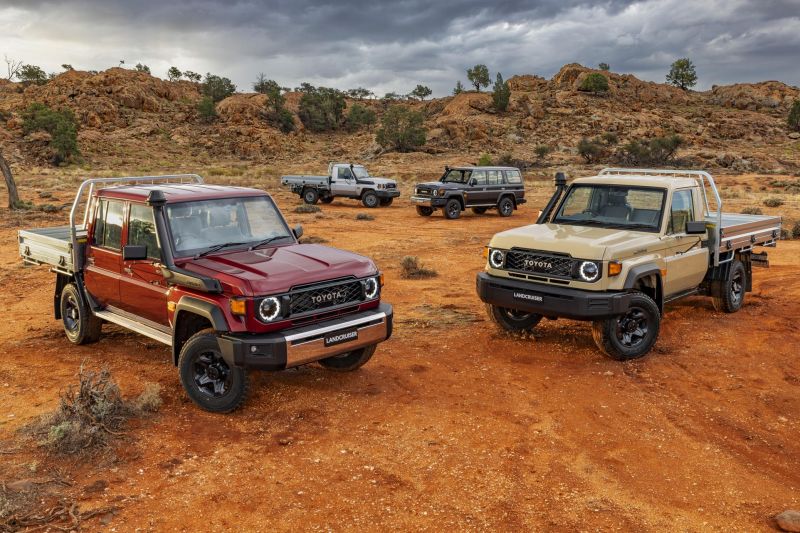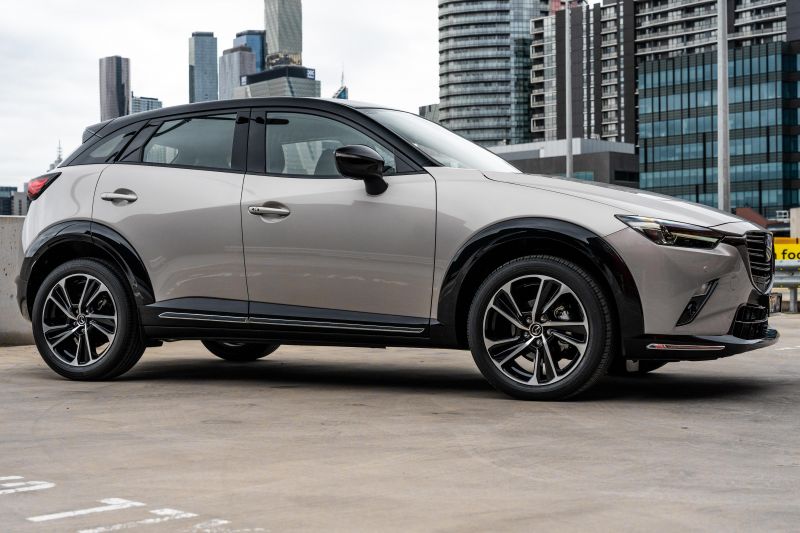The Australian new vehicle market continues to go hell-for-leather as better supply allows car manufacturers to clear order backlogs and fleets to replenish.
November 2023 produced yet another record – six of the past seven months have done so – with 112,141 new cars and commercials counted as sold, up 17.9 per cent.
More importantly it means that 2023 will almost certainly produce an all-time yearly sales record for Australia of around 1.2 million units.
The Australian market totalled 1,118,236 sales (up 12.6 per cent) to the end of November, meaning it’s only 70,880 sales away from eclipsing the 2017 record tally of 1,189,116 units.
However, it’s important to also point out that the record numbers we’re seeing are to a fair degree a reflection of pent-up demand resulting from COVID-era shortages.
As backorder banks subside and economic hardships caused by high inflation and increasing interest rates bite down, expect the market to cool. Many dealer forward order-writes suggest this is already occurring behind the scenes.
“Another record-breaking month underscores the dynamic and competitive nature of Australia’s automotive landscape, showcasing the wide array of choices available to consumers,” said Tony Weber, head of the Federal Chamber of Automotive Industries peak lobby group.
“As the challenges of the past year’s supply chain disruptions recede, consumers have greater access to a broad range of choices and increased accessibility in the market. The automotive sector remains a testament to the resilience and adaptability of both industry players and consumers alike.
“However, as cost-of-living pressures hit we may see a market cooling in the coming months, and we anticipate a more challenging 2024.”
Brands
Toyota’s market share remains lower than the long-term average (18.7 per cent for November) but it’s showing signs of growth and remains the market’s dominant player.
Mazda remains comfortable in second year-to-date and grew a healthy 15.3 per cent in November, with Ford rounding out the podium (up 14 per cent).
Hyundai’s volume grew a healthy 21.7 per cent over November 2022, and YTD it’s neck-and-neck with little sibling Kia (70,296 versus 70,537, with Kia maintaining a slender lead).
Mitsubishi turned a corner after a tough few months to grow 12.8 per cent for the month (it’s still down 19.0 per cent YTD though).
Rounding out the top 10 were Kia (down 5.8 per cent), MG (up 1.9 per cent), Isuzu Ute (up a massive 73.4 per cent), Nissan (up an even healthier 148.9 per cent thanks to its revitalised SUV line-up), and Volkswagen (up 31.5 per cent as European supply improves).
Despite growing volume 79.4 per cent YoY, Tesla finished 11th, and its share of the total EV market declined to 45.6 per cent. It’s traditionally owned 60 per cent or more of the sector until recently but now has more competition.
On the luxury side of things, BMW (2669 sales, up 64.7 per cent) has re-established itself as the top player, ahead of Mercedes-Benz even including the latter’s van range for which BMW has no competitors.
If we just look at passenger car and SUV sales, Mercedes-Benz in November (1997 sales) trailed both BMW as well as Audi (2023 sales). Meanwhile Lexus stayed on record pace with 1271 sales for the month, up 124.2 per cent.
In terms of some of the newer brands on the market, the best performers were GWM (Haval, Tank and Ora included) with 3680 sales, BYD (1257 sales, just one unit behind Honda), Chery (825 sales, ahead of Skoda), and Cupra (514).
See the full list of November sales by brand below:
Models
The Ford Ranger was the top-selling vehicle recording 6301 sales, followed by Toyota HiLux (5901), Isuzu D-Max (3692) Tesla Model Y (3151), and Toyota Prado (3090).
The Ranger has a serious chance at toppling the mighty HiLux in 2023 as Australia’s biggest-selling vehicle, with 55,589 sales YTD with one month to go, versus 55,968 for the Toyota.
- Black = SUV
- Red = passenger car
- Blue = Pickup
- Ford Ranger: 6301
- Toyota HiLux: 5901
- Isuzu D-Max: 3692
- Tesla Model Y: 3151
- Toyota Prado: 3090
- Toyota RAV4: 2449
- Mitsubishi Outlander: 2381
- Mazda CX-5: 2256
- MG ZS: 2047
- Toyota Corolla: 1976
- Hyundai Tucson: 1899
- Mitsubishi Triton: 1687
- Hyundai i30: 1,566
- Kia Sportage: 1,559
- Mazda BT-50: 1511
- Subaru Forester: 1470
- Toyota Landcruiser Wagon: 1458
- Ford Everest: 1389
- Nissan X-Trail: 1361
- Hyundai Kona: 1332
- Toyota Camry: 1214
- MG 3: 1205
- Mazda CX-3: 1200
- Isuzu Ute MU-X: 1161
- Nissan Navara: 1125
Segments
- Micro Cars: Kia Picanto (555), Fiat 500 (51)
- Light Cars under $30,000: MG 3 (1205), Suzuki Swift (659), Mazda 2 (491)
- Light Cars over $30,000: Mini (165), Skoda Fabia (47), Audi A1 (43)
- Small Cars under $40,000: Toyota Corolla (1976), Hyundai i30 (1566), Kia Cerato (782)
- Small Cars over $40,000: MG 4 (835), Audi A3 (397), Volkswagen Golf (351)
- Medium Cars under $60,000: Toyota Camry (1214), Mazda 6 (137), Skoda Octavia (95)
- Medium Cars over $60,000: Tesla Model 3 (788), BMW 3 Series (292), Lexus ES (138)
- Large Cars under $70,000: Skoda Superb (14), Kia Stinger (8), Citroen C5 X (3)
- Large Cars over $70,000: BMW 5 Series (76), Porsche Taycan (56), Mercedes-Benz E-Class (34)
- Upper Large Cars: BMW 7 Series/i7 (12), Mercedes-Benz S-Class (7), Mercedes-Benz EQS (6)
- People Movers: Kia Carnival (665), Hyundai Staria (72), Mercedes-Benz V-Class (62)
- Sports Cars under $80,000: BMW 2 Series (171), Toyota GR86 (117), Subaru BRZ (95)
- Sports Cars over $80,000: BMW 4 Series (69), Mercedes-Benz C-Class (45), Chevrolet Corvette (37)
- Sports Cars over $200,000: Porsche 911 (51), Ferrari range (18), Lamborghini 2-door range (17)
- Light SUVs: Mazda CX-3 (1200), Toyota Yaris Cross (893), Hyundai Venue (575)
- Small SUVs under $45,000: MG ZS (2047), Hyundai Kona (1332), Mazda CX-30 (1081)
- Small SUVs over $45,000: BMW X1 (758), Audi Q3 (423), Volvo XC40 (419)
- Medium SUVs under $60,000: Toyota RAV4 (2449), Mitsubishi Outlander (2381), Mazda CX-5 (2256)
- Medium SUVs over $60,000: Tesla Model Y (3151), Lexus NX (661), Mazda CX-60 (456)
- Large SUVs under $70,000: Toyota Prado (3090), Ford Everest (1389), Isuzu MU-X (1161)
- Large SUVs over $70,000: Land Rover Defender (368), BMW X5 (330), Mercedes-Benz GLE (264)
- Upper Large SUVs under $120,000: Toyota LandCruiser (1458), Nissan Patrol (941), Kia EV9 (98)
- Upper Large SUVs over $120,000: BMW X7 (97), Lexus LX (59), Mercedes-Benz G-Class (47)
- Light Vans: Volkswagen Caddy (63), Peugeot Partner (30)
- Medium Vans: Toyota HiAce (650), LDV G10 (287), Hyundai Staria Load (198)
- Large Vans: Mercedes-Benz Sprinter (363), LDV Deliver 9 (315), Renault Master (158)
- Light Buses: Toyota HiAce (171), LDV Deliver 9 (42), Toyota Coaster (26)
- 4×2 Utes: Toyota HiLux (1058), Isuzu D-Max (659), Mitsubishi Triton (355)
- 4×4 Utes: Ford Ranger (6000), Toyota HiLux (4843), Isuzu D-Max (3033)
- Utes above $100,000: Ram 1500 (309), Chevrolet Silverado 1500 (262), Chevrolet Silverado HD (78)
Miscellaneous
EV-specific model top-sellers*:
- Tesla Model Y: 3151
- MG 4: 835
- Tesla Model 3: 788
- BYD Atto 3: 668
- BYD Dolphin: 589
- Kia EV6: 212
- Polestar 2: 191
- Mercedes-Benz EQA: 169
- Cupra Born: 103
- Hyundai Ioniq 6: 98
- Kia EV9: 98
- BMW i4: 93
- Hyundai Ioniq 5: 88
- GWM Ora: 69
- Porsche Taycan: 56
Doesn’t include models with both ICE and EV options e.g. MG ZS or Hyundai Kona. We will run a full EV breakdown when we get more data
Sales by region
- New South Wales: 34,728, up 17.5 per cent
- Victoria: 29,618, up 16.0 per cent
- Queensland: 24,264, up 17.7 per cent
- Western Australia: 11,679, up 20.8 per cent
- South Australia: 7281, up 28.3 per cent
- Tasmania: 2022, up 13.4 per cent
- Australian Capital Territory: 1628, up 13.0 per cent
- Northern Territory: 921, up 13.0 per cent
Category breakdown
- SUV: 62,347 sales, 55.6 per cent market share
- Light commercials: 26,772 sales, 23.9 per cent market share
- Passenger cars: 18,470 sales, 16.5 per cent market share
- Heavy commercials: 4552 sales, 4.1 per cent market share
Top segments by market share
- Medium SUV: 22.2 per cent market share
- 4×4 Utes: 18.8 per cent market share
- Small SUV: 13.8 per cent market share
- Large SUV: 13.1 per cent share
- Small Car: 8.1 per cent share
Sales by buyer type
- Private buyers: 56,793 sales, up 13.9 per cent
- Business fleets: 39,797 sales, up 25.5 per cent
- Rental fleets: 7883 sales, up 19.2 per cent
- Government fleets: 3116 sales, up 31.5 per cent
Sales by propulsion or fuel type
- Petrol: 50,474 sales, 45.0 per cent market share
- Diesel: 41,946 sales, 37.4 per cent market share
- Hybrid: 9646 sales, 8.6 per cent market share
- Electric: 8646 sales, 7.7 per cent market share
- PHEV: 1429 sales, 1.3 per cent market share
- Hydrogen FCEV: 0
Sales by country of origin
- Japan: 32,383 sales, up 16.5 per cent
- Thailand: 26,407 sales, up 23.5 per cent
- China: 18,036 sales, up 24.9 per cent
- Korea: 13,235 sales, up 7.3 per cent
- Germany: 5438 sales, up 77.2 per cent
Some previous monthly reports
Got any questions about car sales? Ask away in the comments and we’ll jump in!







